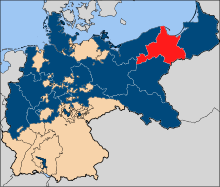
Back بروسيا الغربية Arabic Заходняя Прусія Byelorussian Заходняя Прусія BE-X-OLD Западна Прусия Bulgarian Prússia Occidental Catalan Západní Prusko Czech Zôpadné Prësë CSB Vestpreussen Danish Provinz Westpreußen German Okcidenta Prusio Esperanto
| Province of West Prussia Provinz Westpreußen (German) | |
|---|---|
| Province of Prussia | |
| 1773–1829 1878–1919 | |
 West Prussia (red), within the Kingdom of Prussia (blue), within the German Empire, as of 1878. | |
 West Prussia | |
| Anthem | |
| Westpreußenlied "Song of West Prussia" (1878–1919) | |
| Capital | Marienwerder (1773–1793, 1806–1813) Danzig (1793–1806, 1813–1919) |
| Demonym | West Prussian |
| Area | |
• 1910 | 25,534 km2 (9,859 sq mi) |
| Population | |
• 1910 | 1,703,474 |
| History | |
• Established | 1773 |
• Division by Napoleon | 1806 |
• Restored | 1815 |
| 1824–1878 | |
| 1919 | |
• Disestablished | 1919 |
| Political subdivisions | Danzig Marienwerder |
| Today part of | Poland |
The Province of West Prussia (German: Provinz Westpreußen; Kashubian: Zôpadné Prësë; Polish: Prusy Zachodnie) was a province of Prussia from 1773 to 1829 and from 1878 to 1919. West Prussia was established as a province of the Kingdom of Prussia in 1773, formed from Royal Prussia of the Polish–Lithuanian Commonwealth annexed in the First Partition of Poland. West Prussia was dissolved in 1829 and merged with East Prussia to form the Province of Prussia, but was re-established in 1878 when the merger was reversed and became part of the German Empire. From 1918, West Prussia was a province of the Free State of Prussia within Weimar Germany, losing most of its territory to the Second Polish Republic and the Free City of Danzig in the Treaty of Versailles. West Prussia was dissolved in 1919, and its remaining western territory was merged with Posen to form Posen-West Prussia, and its eastern territory merged with East Prussia as the Region of West Prussia district.
West Prussia's provincial capital alternated between Marienwerder (present-day Kwidzyn, Poland) and Danzig (Gdańsk, Poland) during its existence. West Prussia was notable for its ethnic and religious diversity due to immigration and cultural changes, with the population becoming mixed over the centuries. Since the early Middle Ages the bulk of the region was inhabited by West Slavic Lechitic tribes (Pomeranians in the Pomerelia region and Masovians in Kulmerland), while the actual Old Prussians (Pomesanians and Pogesanians) populated only the remaining part of the territory lying to the east of the Vistula River. The Teutonic Order's conquest of the region resulted in German colonization in the 14th century. As a result of Germanisation, Germans became in the middle of the 19th century the most numerous ethnic group in West Prussia as a whole, remaining as such until the dissolution of the province in 1920, though their distribution was uneven: their majority was concentrated in Danzig, the western lands of the province, along the Vistula river, and in the Pomesanian and Pogesanian portion of the province located east of the Vistula, with a small admixture of Poles (Gedanians and Powiślans). Meanwhile, Poles (Kociewians, Borowians and Chełminians) as well as Kashubians continued to predominate in parts of Pomerelian territories west of Vistula and in parts of the Chełmno Land, forming altogether around 36% of the population of the province as a whole. There were also sizeable minorities of Mennonites and Jews settling in the region.

